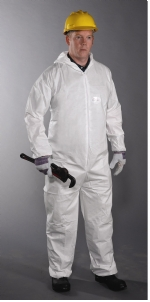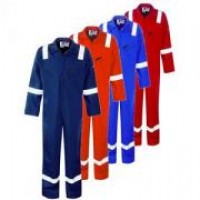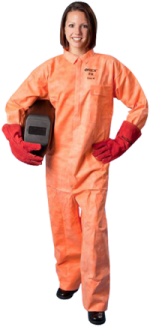Is This What You Want Your Workers Wearing for Hot Work?

If we can believe our site metrics, pictures of workers doing dangerous jobs without the right PPE seem to resonate with you folks. And this photo might just turn out to be the most startling of these PPE nightmares that we’ve ever run.
The Moral: We can’t see his face but let’s assume the worker’s wearing the right head, face and eye protection. And just maybe his boots provide adequate foot protection. The one problem there’s no getting around is the jeans and tee shirt. OSHA (Section 1910.252(b)(3)) requires you to ensure that workers performing hot work operations like brazing and welding wear suitable protective clothing. Unless these items are made of fire-resistant materials, the jeans and tee shirt the worker in this photo is wearing don’t make the “protective” grade.
Body Protection for Hot Work: WHAT’S AT STAKE
3 Reasons to Pay Attention
- More than 500,000 U.S. workers in a variety of industries perform hot work like welding, cutting and brazing
- Statistically, more than 125 of these workers will be killed on the job
- Wearing the right protective equipment goes a long way toward cutting your own risks of death or serious accident
5 Kinds of Protective Clothing
Protective clothing shields you from hot work hazards like extreme heat, splashes from molten metals and other hot liquids, potential impacts from tools and machines and hazardous chemicals. Protective clothing comes in a variety of materials designed to protect a different kind of hazards. 5 common types:
1. Paper-like fiber used for disposable suits protect against dust and splashes

2. Treated wool and cotton adapt to temperature changes, resist fire and protect against dust, abrasions, i.e., rubbing and friction and rough, irritating surfaces

3. Duck, a closely woven cotton fabric that protects against cuts and bruises when handling heavy, sharp or rough materials

4. Leather protects against dry heat and flames

5. Rubber, rubberized fabrics, neoprene and plastics protect against different chemical and physical hazards—check the label to find out what a particular item protects against

8 Protective Clothing Types
- Keep protective clothing clean and free of oils, greases and stuff that can catch fire
- When using protective shirts, wear one that’s long sleeved, has button cuffs and a collar to protect your neck
- Tape shirt pockets closed or button them up so they don’t collect sparks or dusts
- Make sure pants don’t have cuffs that can also collect sparks and dusts
- Repair any frayed edges, tears or holes in protective clothing—or throw the stuff out if it can’t be repaired
- Remove ignitions sources like matches from your pockets
- Try to keep sparks away from your clothing
- Be aware that fire-resistant fabrics become less effective after they’ve been laundered a lot